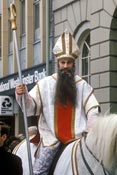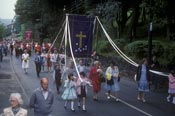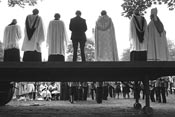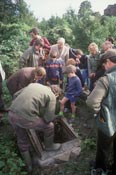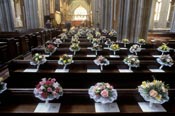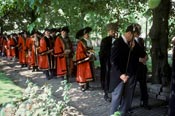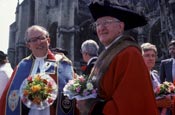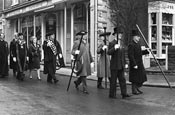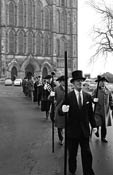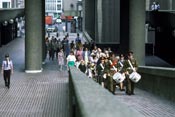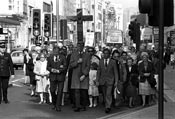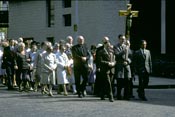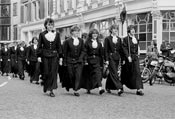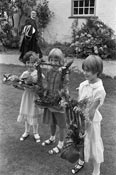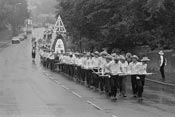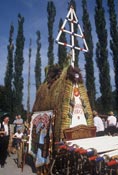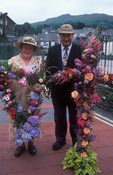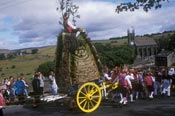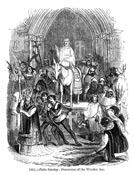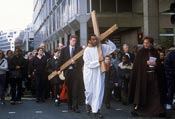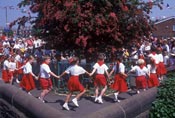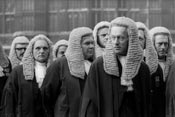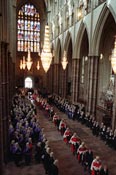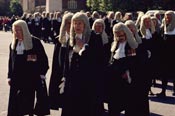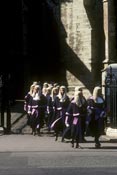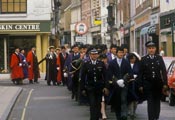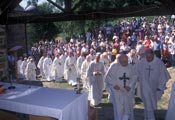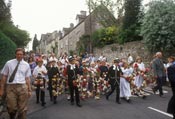
In some church events the procession to and from it may be the most visible, but less important, part. Thus it is the procession is the part that everyone remembers.
‘St Wilfrid’ leads a procession of floats through the streets of Ripon in commemoration of his founding of the Cathedral, and being the first bishop, in the year 672. On Whit Friday a dozen villages in the Saddleworth area march to Uppermill for an open air service. In Bristol the Vicar, Churchwardens, interested parishioners, journalists and photographers hold the ‘Pipe Walk’ from Knowle to St Mary Redcliffe church to inspect the pipe and give thanks to Sir Robert de Berkeley for providing fresh water in the 12th century. On Whit Sunday the same church sees a splendid procession of the Lord Mayor, High Sheriff, Judges, Councillors and other officials to the Rush Sunday Service, instituted (and paid for) by a former Lord Mayor in 1493. Lesser processions take place around the country on the first Sunday after the election of of a new Lord Mayor – as at Winchester. Warrington Walking Day would be the biggest Whit Walk of them all only it takes place on the nearest Friday to the beginning of July. About 6000 walk, from churches and schools of all denominations, led by a bewildering variety of bands. It is an opportunity to be amazed at how many types there are. Back in Ripon , on five ‘Horn Days’ throughout the year the Hornblower leads the mayor and other city dignitaries in procession to and from the Cathedral. Bounds Beating processions appear in many parishes especially on Ascension Day. The Tyburn Walk, from Newgate Prison (now the Old Bailey) to Tyburn Gallows (at Marble Arch) commemorates 105 Catholic martyrs who made the journey during the Reformation – though 2011 may have been for the last time. Christ’s Hospital School is in Horsham now but it was founded in 1552 in a building almost opposite the Old Bailey and next to St Sepulchre’s Church. Every September, after the ‘spital sermon’, the ‘Bluecoat March’ was from there to the Mansion House but recently the service moved to St Paul’s Cathedral and the march starts there. The Bluecoat Boys and Girls take part in the Lord Mayor’s Show as well, led by their fine brass band.
Until the advent of central heating systems churches were cold and damp places so a way to make them less of a penance was to strew the floor with rushes. In time rituals evolved around the annual replacement of the rushes. Rushcarts were elaborately loaded and decorated then pulled to village churches by cohorts of burly parishioners. ‘Rushbearings’ were made in symbolic forms and carried by the children in their Sunday best – though their actual construction would be by experienced adults. Once widespread these ceremonies are now confined to the north of England. Cumbria favours pretty Rushbearing processions by children while Yorkshire prefers more rugged Rushcarts.
Palm Sunday, the last before Easter, was the day Jesus rode into Jerusalem on a donkey, re-enacted annually throughout the Christian word ever since. Good Friday processions with Jesus carrying his cross are also held – this one in London, from Catholic Westminster Cathedral along Victoria Street to Anglican Westminster Abbey for an ecumenical service, was founded in 1990. ‘Bawming the Thorn’ in Appleton Thorn, Cheshire, was once part of the village ‘Walking Day’ in the tradition of nearby Warrington but on a much smaller scale. The thorn tree, inevitably grown from a cutting from the Holy Thorn of Glastonbury, is decorated with red ribbons while the children dance around it. Back in London, on the first practical day in October the beginning of the Legal Year is marked by impressive services in Westminster Abbey and Westminster Cathedral followed by a grand procession of the senior judiciary, led by the Lord Chancellor, across the road to the Houses Of Parliament for ‘The Chancellor’s Breakfast’ – not a ‘full English’, we are reliably informed, but ‘the kind of things you get at cocktail parties’. The Padley Chapel Ceremony commemorates the death of three Catholic priests hanged, drawn and quartered for their beliefs in 1588. The children are carrying their garlands through Bisley in the Cotswolds to dress the elaborate Victorian well in the village.
